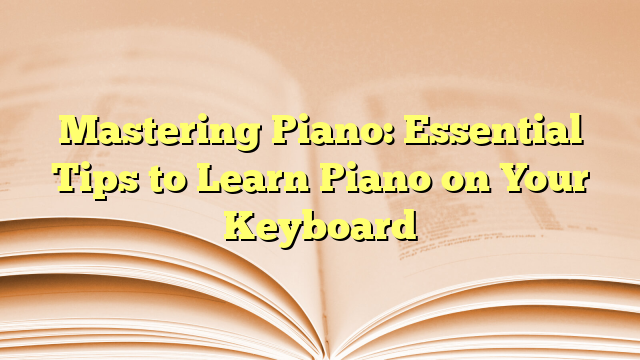Ever dreamt of playing the piano like a pro? I'm here to tell you it's entirely possible, even if you're starting from scratch. In this article, we'll explore how to learn piano on a keyboard, turning that dream into a reality.
You might be thinking, "Can I really learn piano on a keyboard?" Absolutely! Keyboards are an excellent tool for beginners, providing a more affordable and portable option than traditional pianos. We'll delve into the best strategies, resources, and tips to help you master the art of piano playing.
No need for expensive lessons or high-end equipment. With a keyboard, dedication, and the right guidance (which I'll provide), you'll be creating beautiful music in no time. So, stick around if you're ready to embark on an exciting musical journey.
Choosing the Right Keyboard for Learning Piano
Let me jump right into what it takes to pinpoint the keyboard that's best suited for your piano learning needs.
First and foremost, it's crucial to decide what you want in a keyboard. Ask yourself these questions: Do you want it to mimic an acoustic piano? Is portability a top concern? How much are you willing to spend? The answers to these questions will guide your decision.
When choosing a keyboard for learning piano, the number of keys is significant. Standard pianos have 88 keys. However, keyboards can greatly vary, some offer 61 keys while others provide up to 88 keys, just like a real piano. If you're just starting out, a 61-key keyboard is enough to learn the basics and understand the layout. However, if you want to play a wider range of music, go for the 76 or 88 keys.
The feel of the keyboard is another crucial aspect. Some keyboards are equipped with weighted keys that mimic the experience of playing an acoustic piano. This could be a great feature if your goal is to eventually transition to an acoustic piano.
Similarly, the sound quality of the keyboard can greatly affect your learning experience. Don’t forget to test out the built-in speakers to ensure they deliver a pleasant sound that truly enhances your practice sessions.
Finally, you might also want to consider additional features such as in-built lessons, recording functions, and USB connectivity. These can potentially make your learning process smoother and more interactive.
To sum things up, it's all about finding a balance between your individual needs and the features offered by the keyboard. Whether you're a newbie just dipping your toes or an intermediate aiming to polish your skills, the right keyboard can truly make a world of difference in your musical journey. Let's carry on and explore some handpicked keyboards that can assist you in this beautiful venture into the realm of piano playing.
Understanding the Basics of Piano Playing
To get better at piano playing, it's essential to grasp the basics. Just like learning any other musical instrument, piano playing involves mastering fundamentals like proper posture, finger placement, and reading music.
Let's not forget that a good posture has a lot to do with playing the piano effortlessly. You'd want to ensure your back's straight, arms balanced and hands comfortably positioned over the keys. Get a sturdy chair or bench, set at the right height, and you're all set. Regular practice in the correct posture not only helps prevent strain and injury but also enhances your performance over time.
Next, it's paramount to learn about finger placement and movement. Yes, every fingertip has its role on the keyboard! Pianists use all ten fingers, and each finger has its distinct number: Thumb is 1, Index is 2 and so on until the little finger which is 5. Knowing this numbering system is vital for sheet music as well. Generally, your fingers should be curved, relaxed but firm enough to play the notes accurately.
One element of piano playing that can’t be overlooked is the ability to read sheet music. The staff, notes, rests, scales – understanding these concepts might seem daunting, but trust me, they're your keys to mastering the piano. It's an absolute necessity to read and play simultaneously, which substantially enhances your piano playing skills in the long run.
Talking about the basics, we can't ignore practicing scales. Pianists worldwide agree that practicing scales plays an integral part in understanding the structure of music. Scales help him not only with finger placement and movement but also with developing an intuitive sense of melody and harmony. Dive into the C Major scale first - it's simple as it uses only the white keys on the keyboard.
Building a Strong Foundation with Proper Technique
Learning the piano comes with its fair share of challenges but with the right foundation in technique, honing these skills gets easier. As with any instrument, technique is crucial when it comes to the keyboard. A strong, well-practiced technique can significantly enhance the richness and expression of your music.
One critical component of good technique is hand position. A relaxed and natural hand position can allow for fluid movement, precision in striking keys, and prevent unnecessary strain. Imagine you're holding a small ball in your hand while placing it on the keyboard - this loose hold allows for better control and minimal tension.
Your finger strength and fluidity will depend largely on your practice. Scales are an excellent way to work on these. They're essential for grounding your fingers on the keyboard and help to facilitate smooth musical transitions.
When practicing scales, I've found it helpful to:
- Start with a single octave
- Play slowly to focus on hitting each note correctly
- Increase speed gradually
- Experiment with different rhythm patterns
It's also common for pianists to misjudge the pressure they apply on the keys. A light touch might seem like the way to go, but too much lightness can cause loss of control over keys. It's always a good idea to test and adjust your pressure as you continue your practice.
To cap it off, reading sheet music is another critical building block for technique. It improves your understanding of rhythm, melody, and harmony. Equally, it enhances your ability to play from memory, which is a bonus for any keyboard player.
There's no shortcut to it. Consistent practice and focus on these techniques are key in your journey to mastering keyboard. Indeed, Rome wasn't built in a day! Don't be too hard on yourself if you're not seeing progress right away but when you do, it'll be well worth it.
Learning Musical Notation and Reading Sheet Music
Up next on our journey to mastering the keyboard is understanding musical notation and getting comfortable with reading sheet music. Like any other new language we learn, this won't be an overnight process. But trust me, it's worth every bit of the effort. Reading sheet music gives you access to a vast library of piano literature. More than that, it's an essential skill that goes hand-in-hand with developing your piano technique.
Musical notation is, in essence, a set of symbols that represent the pitch, rhythm, and tempo of a piece. Fundamental elements include notes, rests, clefs, time signatures, and key signatures among others. As these components come together, they create the language of music.
- Notes signify the pitch. They show us which keys to play on the keyboard.
- Rests direct us when to stay silent.
- Clefs provide context for notes, determining their pitch value.
- Time signatures dictate the rhythm of the piece.
Amidst your learning journey, you'll also encounter various other symbol groups responsible for articulation, dynamics, and tone color. So how do you start making sense of all these signs and symbols? Begin with an understanding of the basics, then gradually move on to more complex elements.
When starting with sheet music, focus on recognizing notes and rhythms. Identify them on the keyboard. This will help you gain a meaningful understanding of how notation corresponds to the keyboard layout. Practice regularly, and over time you'll notice your reading skills getting sharper. Following this, you'll also be able to play more complex pieces.
Just as we've discussed before, consistency is key in mastering the keyboard, and learning to read sheet music is no different. Remember, patience, perseverance, and practice will pave your way to proficiency.
Practicing Effectively to Progress Quickly
Breaking down the daunting task of learning piano into manageable sessions is the cornerstone of effective practice. This approach not only prevents overwhelm but actually speeds up your progress.
I'll let you in on a little secret. It's a principle that's rooted in both cognitive psychology and my own years of experience: quality trumps quantity when it comes to practicing. An hour of focused, deliberate practice is worth far more than three hours of mindless repetition.
When mapping out your practice sessions, there are three core components to consider: Duration, Content, and Frequency.
Duration
This is purely about the length of your sessions. The ideal duration tends to be a sweet spot between 20 to 60 minutes. Any less and you might feel as though you're just getting started when it's time to wrap up. Any more, and mental fatigue can hinder progress.
| Ideal Duration | 20 - 60 minutes |
Content
Content is all about what you're playing. For beginners, it's crucial you spend time familiarizing yourself with keys and chords while slowly introducing more complex pieces as your skills advance.
Remember to strike a balance! Repetitive drills can strengthen specific abilities but they are not a substitution for real music. Mix up drills with actual songs to provide much-needed variety and keep your practice sessions enjoyable.
Frequency
Last but not least, how often you hit those keys matters considerably. Consistency is key here. A quick 20-minute session every day is far more effective than a two-hour marathon once a week. Regular exposure helps reinforce the neural pathways responsible for understanding and replicating musical patterns.
In sum, break your practice into manageable chunks while prioritizing quality over quantity. Keep your sessions varied, enjoyable and above all, consistent! As with any skill, it's all about laying solid foundations and continually building upon them over time — all it takes is patience and persistence.
Exploring Online Resources and Apps for Learning Piano
Jumping into the digital age, it's clear to see the wealth of resources available at our fingertips. Gone are the days when one-to-one lessons were the only method to learn piano. Let's explore some online resources and apps that can help you soar in your journey of learning the piano on the keyboard.
Online learning platforms have emerged as a dominant force in the education sector. They're versatile, convenient, and often more affordable. More importantly, they're flexible and adaptable to your specific learning style. Websites like Udemy, Coursera, and Khan Academy offer courses in piano learning. These encompass beginner levels to advanced techniques. They typically include video lessons, worksheets, and interactive sessions.
An interesting, and often overlooked, virtual space is YouTube. A vast and diverse community of piano instructors share their expertise via tutorials, lesson plans, and even live streams. YouTube channels such as 'PianoVideoLessons' and 'HDpiano' are well-acclaimed by the community for their quality content.
Here are some of the most highly-rated apps for learning piano:
| App | Price | Features |
|---|---|---|
| Simply Piano by JoyTunes | $120 per year | Interactive lessons, sheet music, offline mode |
| flowkey | $19.99 per month | Visual cues, varieties of music styles and genres |
| Piano Maestro by JoyTunes | Free with in-app purchases | Recommended for kids, colorful and interactive |
These apps offer innovative features, like listening to you play and providing real-time feedback. They cover a wide array of topics, including rhythm, reading sheet music, and playing different genres of music.
That said, be sure to balance digital aids with self-practice. The theories and techniques you learn online should be put into practice on your own keyboard. Remember that quality trumps quantity. Be patient, practice smart, and persist. Let's continue exploring other aspects of learning piano on a keyboard...
Tips and Tricks for Mastering Piano Playing
The journey towards becoming an accomplished pianist goes beyond diligent practice and using online resources. It includes discovering unique strategies that can enhance your playing technique and musical understanding. Here are some valuable tips and tricks that'll guide you on your path to mastering the piano.
To start with, observe correct body positioning. As simple as it may seem, how you position your body can greatly affect your playing. Keep your back straight, avoid stiff shoulders, and ensure your arms form an L-shape at the elbow when striking the keys. Achieving perfect form provides greater access to the keys and improves your piano playing stamina.
In addition, understanding musical notation is an essential skill every pianist should master. As you progress, it becomes increasingly important not just to read, but to interpret musical notes accurately. This means understanding pitch, rhythm, dynamics and other musical symbols that give life to the scores.
Take time also to master scales and chords. They're integral to all musical compositions. A comfortable familiarity with these fundamental structures can boost your ability to improvise, transpose and understand chord progressions in any piece. I can't stress enough the importance of this: Scales and chords are the building blocks of piano playing.
Perfecting the art of playing by ear is another powerful skill. By developing a keen musical ear, you'll enhance your ability to reproduce melodies, understand harmonic structures and even compose your own pieces.
Remember, no matter how perfect your practice regimen, or how advanced your technical skills, the true essence of piano mastery lies in playing with emotion and interpreting the music in a way that resonates with its listener. So continue to press those keys, revamp those melodies and imbue each note with your unique style.
Conclusion
So, there you have it. Learning piano on a keyboard isn't as daunting as it might seem. With the right body posture, a solid grasp of musical notation, and a good handle on scales and chords, you're already on your way to becoming a skilled pianist. And remember, it's not just about hitting the right notes. It's about playing with passion and interpreting the music in a way that speaks to you and your audience. Keep practicing, keep listening, and keep playing with emotion. Your journey to mastering the keyboard is a rewarding one, and I'm confident you'll find joy in every step. Happy playing!
Harlan Kilstein began playing piano during covid with no piano background at all. He taught himself how to play learning what to do and what not to do.
Today he's an advanced intermediate player and can help you grow in your skills because he learned all this on his own.







